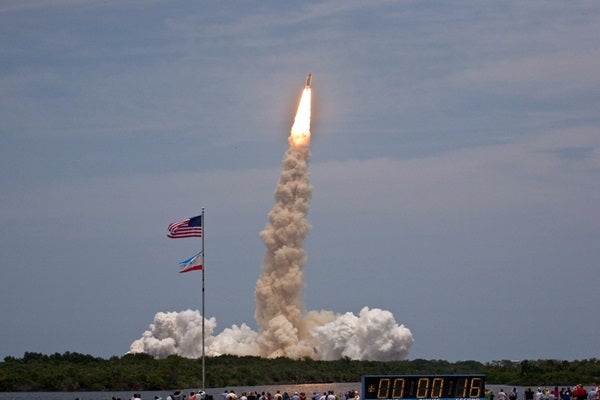The space shuttle Atlantis STS-125 mission successfully launched as scheduled at 2:01 P.M. EDT on May 11, 2009, in the fifth and final service call on the Hubble Space Telescope (HST).
During an 11-day mission, the seven astronauts will complete five spacwalks to install two new instruments, repair two inactive ones, and replace other Hubble components.
The result of the upgrades will be six science instruments with capabilities beyond those now available and an extended operational lifespan of the telescope through at least 2014.
Shortly before liftoff, Commander Scott Altman thanked the teams that helped make the launch possible.
“At last our launch has come along,” said Altman. “…Getting to this point has been challenging, but the whole team, everyone, has pulled together to take us into space.”
Altman is joined on STS-125 by Pilot Gregory C. Johnson and Mission Specialists Megan McArthur, John Grunsfeld, Mike Massimino, Andrew Feustel and Michael Good. McArthur will serve as the flight engineer and lead for robotic arm operations while the remaining mission specialists pair up for the hands-on spacewalk work after Hubble is captured and secured in the payload bay. Altman, Grunsfeld and Massimino are space shuttle and Hubble mission veterans. Johnson, Feustel and Good are first-time space fliers.
The STS-125 mission is the 126th shuttle flight, the 30th for Atlantis and the second of five planned in 2009. Hubble was delivered to space on April 24, 1990, on the STS-31 mission. STS-125 is referred to as Servicing Mission 4, although it is technically the fifth servicing flight to the telescope.
“Hubble has a long history of providing outstanding science and beautiful pictures,” said Ed Weiler, associate administrator for NASA’s Science Mission Directorate. “If the servicing mission is successful, it will give us a telescope that will continue to astound both scientists and the public for many years to come.”
Astronomy Contributing Editor Martin Radcliffe blogs from NASA’s Kennedy Space Center:










